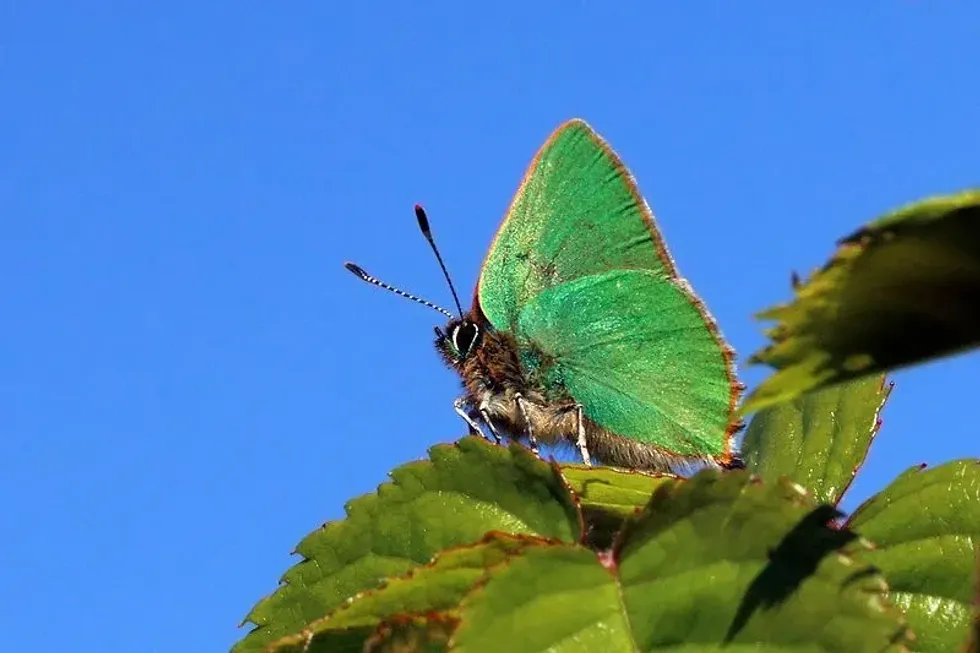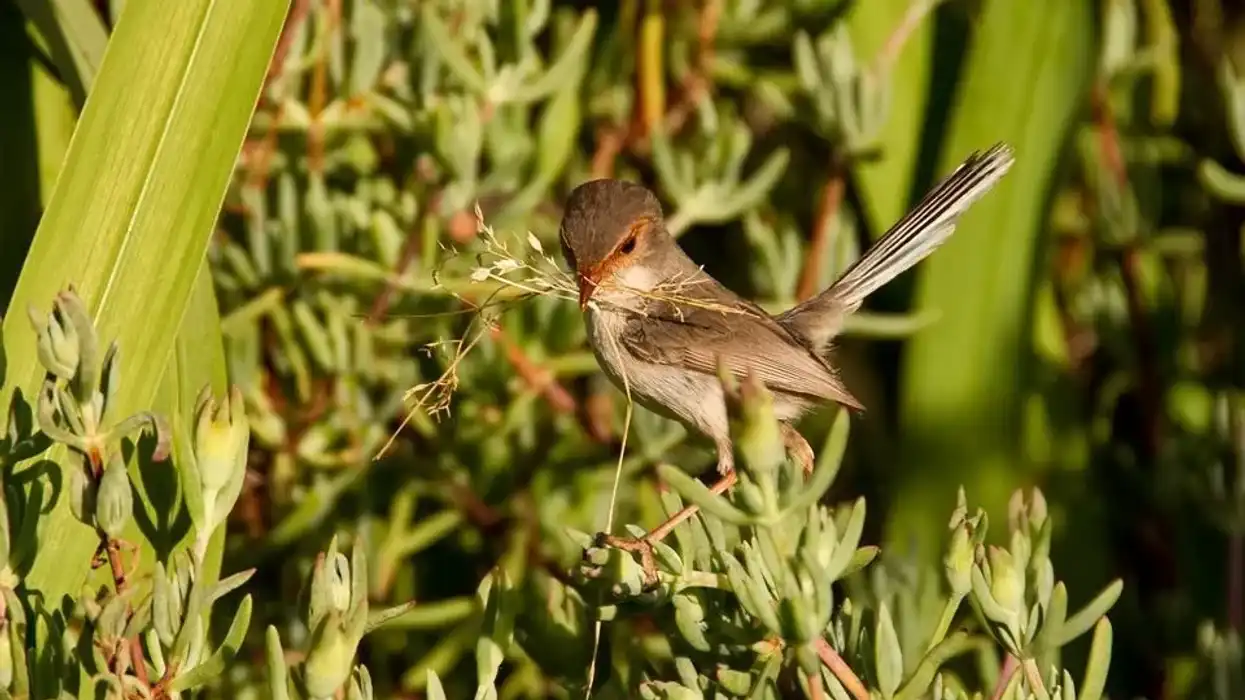There are a total of 18,000 species of butterfly in the world. The hairstreak is one among the same family. There are different variations of hairstreaks including white-letter hairstreak, brown hairstreak, meadow brown hairstreak, and black hairstreak among others.
The green hairstreak, Callophrys rubi, is the only green butterfly species in the UK. These species are spread throughout Britain and Ireland. They are not a garden visitor and are hard to spot.
The green hairstreak, Callophrys rubi, unique feature is that they are always closed except while in flight. The green hairstreak, Callophrys rubi, green color helps it camouflage easily with the green leaves and plants nearby. These species go through a process of metamorphosis before transforming into the beautiful beings that they now are.
The green hairstreak butterfly is a herbivore and feeds on larval foodplants and flower nectar. Green hairstreak butterflies are small-sized unique butterflies. Read on to learn all about the green hairstreak.
For more relatable content, check out morpho butterfly facts and viceroy butterfly facts.
Green Hairstreak Interesting Facts
What type of animal is a green hairstreak?
The green hairstreak is a butterfly.
What class of animal does a green hairstreak belong to?
The green hairstreak is a type of butterfly that belongs to the Insecta class, family Lycaenidae and genus Callophrys.
How many green hairstreaks are there in the world?
The exact population of the green hairstreaks in the world is not evaluated. There are about 17,500 species of this butterfly in the world and 750 species in the United States. They can be spotted from March to June.
Where does a green hairstreak live?
The green hairstreak lives in the UK mostly where they are the only species of green butterflies. They are seldom seen around urban dwellings or gardens. They live in small colonies and their populations have faced a severe decline in recent decades.
What is a green hairstreak's habitat?
Green hairstreaks live in a wide range of habitats. The wide range of habitats including woodlands, scrubby grasslands, bogs, and old quarries. They have a wide range of foods that they consume making them adaptive in their environment. They prefer habitats of scrubs and shrubs.
Who do green hairstreaks live with?
Green hairstreaks live in and breed in colonies. They come together for mating. They are rarely spotted unless it's spring. The caterpillar consumes foodplants including common rock rose, bird's foot trefoil, bilberry, broom, and dogwood. They also consume flower nectar. Adults consume honeydew and bird's foot trefoil.
How long does a green hairstreak live?
Green hairstreaks go through a process of metamorphosis. Adults' exact lifespan is not known however, they have short lifespans. The oldest records of a butterfly go back to 200 million years ago.
How do they reproduce?
Male green hairstreaks and female green hairstreaks reproduce sexually. The male is territorial. The male green hairstreak during spring and wait at their perching sites for a female. Post-mating females lay their eggs by themselves.
Eggs hatch a week later and go through a process of metamorphosis. Once they become a caterpillar they begin feeding immediately. During summer the caterpillars go into the ground and pupate during winters in the leaf litter. Post metamorphosis the caterpillars emerge out of their shells into beautiful butterflies.
What is their conservation status?
The conservation status of the green hairstreak is not evaluated by the International Union For Conservation Of Nature (IUCN).
Green Hairstreak Fun Facts
What do green hairstreaks look like?
Green hairstreaks are predominantly green in color and are similar to Sheridan's green hairstreak butterfly which is found in North America and nearby regions however, they are a little darker. In the caterpillar stage, they are hairy, bright green, and have markings along their back. Adult butterflies have metallic green undersides with a white streak.
When seated the underside of its wings can be seen since they rest with their wings closed showcasing their undersides. Their underside wings are colorful. They go through a process of metamorphosis before becoming adults. The stages include larvae or eggs, caterpillars, chrysalis, and finally an adult.
Females and males appear more or less similar in appearance but they differ in their functions. Males have a spiraling flight close to the leaves, shrubs, or scrubs, and females are seen while laying eggs. Their wingspan is 1-1.2 in (2.6-3.3 cm).

How cute are they?
The green hairstreak species of butterflies are extremely cute and adorable. They consume a wide range of food plants. They are seen primarily near grassland, woodland, shrubs, and scrubs. They can be spotted from March to June.
How do they communicate?
Green hairstreaks communicate through chemical cues. Males produce chemicals to produce pheromones to seduce females. They communicate via sound as well as body language in their habitats.
How big is a green hairstreak?
The green hairstreak is 1-1.2 in (26-30 mm) in length which is 10 times bigger than the smallest moth which is the Stigmella maya at 0.04 in (1.2mm).
How fast can green hairstreaks fly?
Green hairstreaks fly at moderately good speeds. The fastest butterflies are the skippers who can fly up to 37 mph (59.5 kph) and have some of the fastest reflexes and fly through grassland, woodland, plants, and other similar habitats.
How much does a green hairstreak weigh?
The green hairstreak weighs 0.44 lb (0.2 kg). Queen Alexandra's birdwing is the largest butterfly in the world. Their weight depends on their diet and their habitat.
What are the male and female names of the species?
Male and females are not addressed differently. Male and females are similar in appearance however they differ in reproductive functions.
What would you call a baby green hairstreak?
A baby green hairstreak is called a larva or a nymph. They grow through a process of metamorphosis and develop through the process of self-development in their habitats.
What do they eat?
They live in woodland or grassland habitats and are primarily herbivores. Green hairstreaks live in their habitat and caterpillar consumes foodplants including common rock rose, bird's foot trefoil, bilberry, broom, and dogwood. They also consume flower nectar available in nature. Adults consume honeydew and bird's foot trefoil.
Are they dangerous?
No. These butterflies are not dangerous in nature. They are seldom seen out in the open and reside mostly in the European regions. The caterpillar too is not seen out in the open and reside in specific zones.
Would they make a good pet?
Butterflies are kept as pets as well as caterpillars. Green hairstreaks are endemic to the UK and are seen near plants, woodland, and grassland hence it's difficult to spot them easily.
If you wish to keep them as pets it's essential to enquire about the legalities in your region related to such species. If you wish to see them in their natural habitat they can be seen from March to June.
These species are the only green butterflies in the UK. There are various butterfly wildlife parks where they keep butterflies in enclosures for you to observe them.
Did you know...
All butterfly wings are transparent. The color you see on their wings is made up of scales. The wings themselves are made of protein.
All butterflies use their feet to taste. This is one of the primary reasons land on colorful things to see if they can find food.
The purple emperor butterfly is the second largest butterfly in the United Kingdom. It has a lifespan of one to six months.
There is only one brood of white admiral butterfly in a year. Adults emerge from June to July.
Spotting green hairstreaks
Spotting green hairstreaks is hard since they camouflage easily however, they can be spotted easily in the months of March to June. It's essential to locate them in their natural habitat, that is, near plants, woodlands, and grasslands. They blend in easily with nature and you need a keen sense of sight to spot such species.
Do other green butterflies exist?
Yes, there are various different kinds of green butterflies including the tailed jay, Sheridan's green hairstreak, emerald peacock swallowtail, malachite, Obrina olivewing, and dido longwing. All species are green but vary in their shades, pattern, and coloration.
Here at Kidadl, we have carefully created lots of interesting family-friendly animal facts for everyone to discover! Learn more about some other arthropods from our monarch butterfly facts and ghost moth facts pages.
You can even occupy yourself at home by coloring in one of our Green Hairstreak coloring pages.









